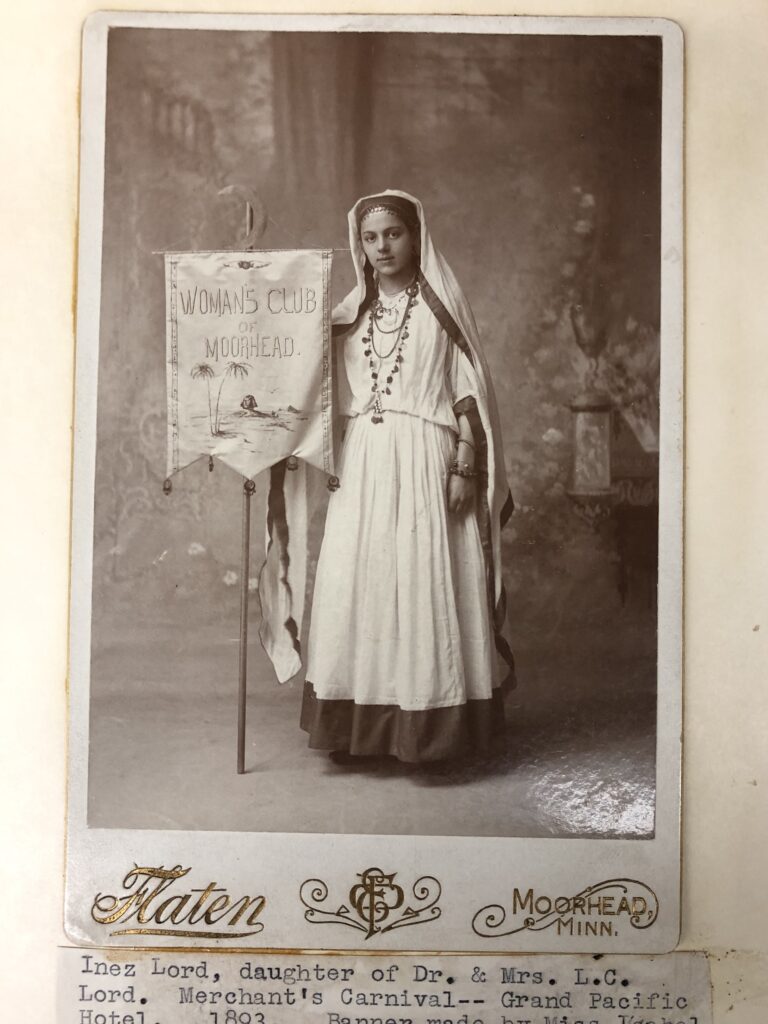clay county histories

Inez Lord, daughter of Mary and Livingston Lord, photographed in costume for the Moorhead Woman’s Club’s 1893 Egyptian theme. Minnesota State University Moorhead Archives.
Markus Krueger | Program Director HCSCC
August 26 will be the 100th Anniversary of the ratification of the 19th Amendment – the culmination of the hard work of generations of Suffragists to get voting rights for women. For the past two years, the Historical and Cultural Society of Clay County and the League of Women Voters of the Red River Valley have been celebrating milestones that led to August 26, 1920. Covid, of course, threw a wrench into everyone’s plans, so we will extend our celebrations through the 2020-21 centennial year, and all this month you can check HCS’s Facebook page for Woman’s Suffrage content.
One of the highlights is a lecture from NDSU’s Dr. Ann Braaten entitled “Extending the Home: Women’s Clubs Work for the Vote” (soon to be posted on our website). Women’s/Woman’s Clubs formed across America starting in the late 1800s to give women a creative and intellectual outlet. The Moorhead Woman’s Club was founded in 1893 at the home of Sarah and Solomon Comstock. Two years later Moorhead became one of 15 charter members of the Minnesota Federation of Woman’s Clubs, which would eventually expand to 40,000 women in 500 chapters, including clubs in Barnesville, Glyndon, Felton, Hawley, and plenty of other towns around here. Although they tend not to call themselves “Woman’s Clubs” anymore, some are still active today, including the Fine Arts Club and the Round Table in Fargo and the Barnesville Literary League.
Each year clubs chose a topic to study – the first topic for the Moorhead club was Ancient Egypt, the 1906-7 season’s topic was Italian Sculpture and Painting in the Sixteenth, Seventeenth, and Eighteenth Centuries, and the group studied Panama and South America in 1913-14. The members wrote essays, recited poems, or performed music on that theme, hosting each other in their homes on a rotating basis. Membership in the Moorhead Women’s Club was limited to 25 plus a list of inactive honorary members. Membership was an indication that you are a woman of culture from an important family. Although these clubs did not always officially endorse Woman’s Suffrage, it should not surprise you that many Suffragists were members of these clubs of educated, civic minded community leaders. Esther Russell, Mary B. Peterson, Edith Darrow Godfrey, and May Burnham were each chairmen of our local branch of the Minnesota Woman Suffrage Association who were either members of the Moorhead Woman’s Club or close family of members.
Moorhead, Fargo and many other towns owe the founding of their public library to their local Woman’s Club. The Moorhead Public Library opened in 1906 thanks to years of effort from the Moorhead Woman’s Club (with the help of local attorney George Perley), who raised money to buy the property, convinced the city to take on the responsibility of operating a library, got robber baron Andrew Carnegie to pay for a building, and filled the place with books. For the next 34 years they even took turns, in alphabetical order, staffing the library on Sundays to give the librarians a day off.

